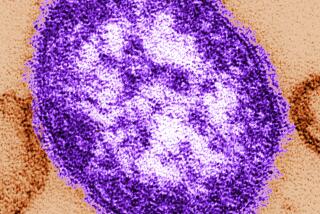Measles outbreak spreading beyond Disneyland visitors
- Share via
The measles outbreak that began at Disneyland during the holiday season is now spreading beyond people who contracted the disease at the theme park, with those patients now exposing others after they arrived back in their hometowns, health officials said Saturday.
There are now 51 confirmed cases of the highly contagious virus across California, three other states and Mexico, and the Orange County Health Care Agency said the rapid rise in cases indicates “the measles outbreak will continue to spread.”
Health officials had hoped to contain the outbreak to Disneyland guests who visited the park between Dec. 17 and 20, when the virus spread from perhaps a single infected person or an ill family. But Orange County is now reporting six new cases of measles involving people who did not visit the park during that period. State officials said there were two more such cases in Ventura County and one in Alameda County.
“It’s pretty ubiquitous now throughout the county,” said Dr. Eric Handler, Orange County’s public health officer and a pediatrician. “Clearly, we have an unprotected population that needs to be immunized to halt the spread of the disease.”
Most of those who were infected never received the measles shot or were only partly immunized.
The biggest fear is that vaccination levels are now so low that the measles outbreak will continue spreading. The wealthy area of southern Orange County has particularly low vaccination levels among kindergartners compared to the state average, according to a Times analysis published in September.
“There is a rather significant marked increase in unvaccinated people,” said Dr. James Cherry, a UCLA infectious diseases expert who has studied measles outbreaks for decades. “The hope is that we can quickly get non-vaccinated people vaccinated ... But this could develop into the worst measles [outbreak] ever since 1989.”
The measles outbreak between 1989 and 1991 infected more than 55,000 people nationwide, causing 11,000 hospitalizations and about 120 deaths, including about 75 in California. A majority of those who died in California were babies and children under the age of 5.
The epidemic was caused primarily by the failure to vaccinate preschool children. Vaccination rates have improved considerably since then, thanks to federal efforts to subsidize vaccines for low-income children in the 1990s. By 2000, the United States had declared the end of domestic measles transmission.
Experts are now warning that a growing anti-vaccination movement could reverse those gains if measles outbreaks aren’t quickly eradicated by a ring of people who have been immunized.
Orange County health authorities said unvaccinated children will be excluded from school or day care for 21 days if they come in contact with a contagious measles patient.
There are now 16 confirmed cases in Orange County. The second-hardest-hit area is San Diego County, with 10 cases — nine of whom were not vaccinated. Also affected are the counties of Los Angeles (8), Alameda (4), Ventura (3), Riverside (2) and San Bernardino (2), for a total of 45 measles cases in California.
The six other confirmed cases involve residents of Colorado (1), Utah (2), Washington state (2), and Mexico (1), where a 22-month-old unvaccinated girl was confirmed to have measles and had attended Disneyland between Dec. 16 and 18.
For more than a decade, measles has been considered eliminated from the entire Western Hemisphere, meaning domestic transmission has ended here. But measles has still been a problem when brought in by travelers from Western Europe and Southeast Asia.
A growing anti-vaccination movement in the United States has been fueled by parents’ fears that the measles vaccine causes autism — a theory that has been thoroughly discredited by numerous scientific studies.
For every 1,000 children who get the measles, one or two will die from it, and one will get brain swelling so severe it can lead to convulsions and leave the child deaf or mentally retarded, according to the U.S. Centers for Disease Control and Prevention. A significant number will be hospitalized with pneumonia, said Dr. Cherry, of UCLA.
“The vaccine is entirely safe,” Cherry said. “Information about adverse effects like autism are just not true.”
Efforts to contain the outbreak can depend on how much it has spread in a given community. The largest measles outbreak since 2000 occurred last March in a predominantly Amish community in Ohio. The outbreak stopped at more than 380 people after a robust campaign to administer 12,000 vaccination doses.
But the far-ranging spread of the current outbreak can make such an effort more difficult.
Health officials are urging people suspected of having measles to first call their health provider before going to a clinic, enabling doctors to make special preparations so patients don’t risk infecting others. An urgent care clinic in the San Diego suburb of La Mesa was forced to shut down last week when five people arrived with the telltale rash.
Measles can be especially severe in babies, toddlers and pregnant women, as well as other adults. Especially vulnerable are infants younger than 12 months, before they get their first dose of the vaccine known as MMR — for measles, mumps and rubella.
“Measles is so contagious that if one person has it, there’s a 90% chance that people close to that person who are also not immune will also become infected,” Handler said.
Measles spreads through the respiratory droplets that become airborne during a cough or sneeze. “You can catch measles just by being in a room where a person with measles has been — even if the person is gone,” according to the CDC.
A person with measles is infectious as soon as coughing and sneezing begin but before the rash appears — first on the head, then spreading to the rest of the body. Patients can be contagious four days before the rash appears and four days after. Other symptoms include fever, eye redness and runny nose.
Last year marked the highest number of measles cases in California and across the nation since 2000, fueled by importation of the disease from the Philippines. In California, there were about 70 measles cases in 2014, up from just 18 in 2013.
State health officials say no new cases have been identified among people who attended Disneyland after Dec. 20. A measles outbreak can start in any location with large numbers of international travelers, such as a convention hall or an airport.
Handler said he hoped parents who have chosen not to inoculate their children will reconsider their decision.
“My hope is people understand the seriousness of measles and how contagious it is, and the disease can be prevented if people will take the vaccination,” Handler said. “If that occurs, then the likelihood of having outbreaks like this will be greatly diminished.”
More to Read
Get the Latinx Files newsletter
Stories that capture the multitudes within the American Latinx community.
You may occasionally receive promotional content from the Los Angeles Times.






